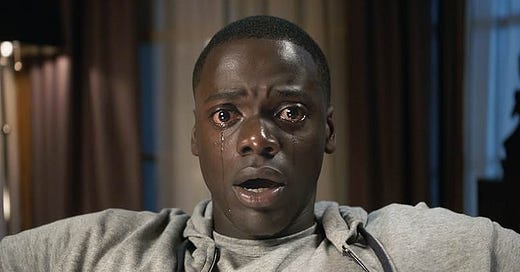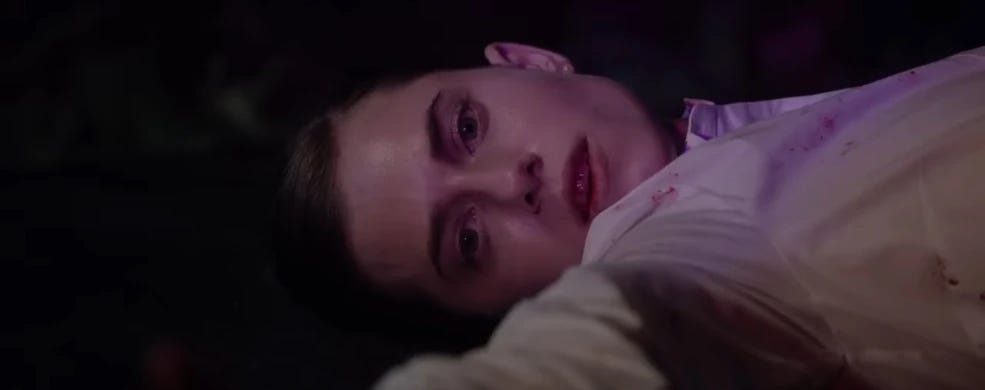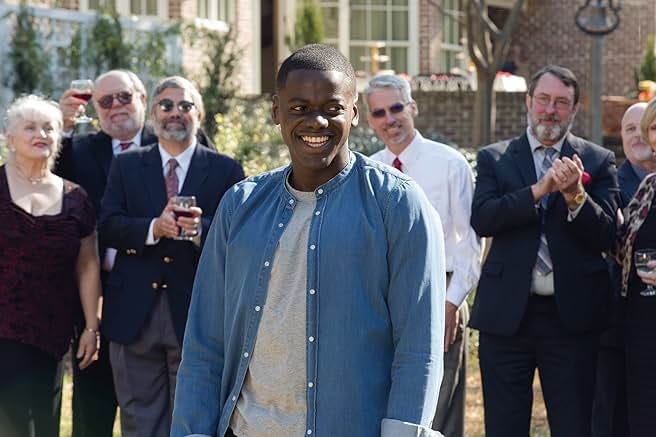In Part 1 of my analysis of Jordan Peele’s 2017 movie, Get Out, I posed two questions:
Question 1: How the hell does Peele get white folks to cheer for a young black man as he kills white folks in their nice home and steals their nice car?
Question 2: Why the hell should we care, in 2025, about a weird movie that came out in 2017?
To refresh your memory, I spent all of Part 1 addressing that first question—that is, how Peele works his filmic magic. I asserted that Peele ingeniously invades the genre of the horror film, twisting its conventional techniques in order to bring across his social messages about race in America. More specifically, I pointed out three of these clever genre-bending devices used by Peele.
Now, for Part 2 of my analysis, I’ll pick up right where I left off.
First, I point out one last neat trick used by Peele as he bends elements of the traditional horror flick to create what he calls a “social thriller.” Second, I explore some answers to Question 2—that is, why paying attention to this movie matters now more than ever.
Genre-Bending Device #4: The Final Boy
In her groundbreaking study of gender in modern horror films, Men, Women, and Chain Saws (1992, updated 2015), Carol J. Clover coins the term “final girl” to describe the stock character, especially in slasher films, who faces off against the monster or psychopathic killer at the end of the movie. This character often possesses special qualities the audience is meant to identify with and to admire. And, indeed, against all odds, this final girl manages to kill the monster and emerge triumphant from the nightmare horror of the plotline.
In his thoroughgoing invasion of the genre of the horror movie, Peele has an absolute field day turning this well-worn filmic convention on its head. Get Out does not present us with a final girl to identify with and pull for; instead, we’re given Chris as the “final boy” of the movie—unfortunate racial pun unavoidable in this case.
As a protagonist, Chris is wholly sympathetic. Because of his basic goodness and innocence, we identify with and root for Chris as he negotiates first the oddity then the sophisticated barbarity of the Armitage estate. In this way, via Chris, moviegoers—irrespective of their race—experience the injustice, violence, and terror of American racism. And, as we’ve seen, Peele makes sure to deliver a blood-chilling, breathtaking, and mind-boggling ordeal for us, through Chris, to undergo.
Chris is a final boy packing a tremendous degree of cultural clout.
Nowhere is Chris’ social punch more in evidence that in Peele’s carefully crafted final moments of Get Out (if you need to refresh your memory, watch here). While in a conventional horror film, Rose would be earmarked to play the heroic role of the final girl, in the frenetic last moments of Get Out, Peele turns her into another familiar trope of horror: the undying monster.
More specifically, Rose is the undying Monstrous White Girl for Chris, as the Black Final Boy, to face down, defeat, and escape.
Even after being shot by the black man whose consciousness is trapped inside of Walter (the Armitage grandfather), Rose, as the undying monster, is still reaching for her rifle. When Chris takes the gun from her, she plies her seduction tactic one last time, telling him, “Chris ... I’m so sorry ... I love you ... I love you.” Justified in his rage, Chris begins to strangle her.
At the very climax of the film, Peele presents viewers with the antithesis of white supremacist dogma: not the black man beast attacking the innocent white woman, but the innocent black man desperately defending himself against the white woman beast.
To make clear this state of affairs, Peele has a strangely triumphant smirk come to Rose’s face as Chris strangles her. It’s as though generating in Chris this violent reaction to her is the monstrous trick Rose wants to play on black men—that is, she looks to spur black men into being the racist stereotype whites have of them as lusting uncontrollably, and sometimes murderously, after delicate white womanhood.
When Chris breaks off his stranglehold, Rose’s expression turns to disappointment, as if she’s failed to turn Chris into the universal Black Thug whites expect. A moment later, when Rose thinks a police car has pulled up, she deftly switches into white victim mode, calling out weakly, “Help ... help ... help me.” At that moment, we think all is lost for Chris. The Monstrous White Girl has won. Surely the racist white cop from early in the film has arrived, and he will interpret this scene of carnage in typical white police officer fashion.
In a plot-twist of genius, though, Chris’ loyal friend, Rod (Lil Rel Howery), steps out of his Airport TSA vehicle, come to the rescue. Chris staggers to the car and climbs in. Rod sizes up the scene for a few moments, then delivers the best line of the film. Maybe the best line of film dialogue ever. With a barely suppressed I-told-you-so tone in his voice, Rod chides, “I mean, I told you not to go in that house.” It’s a warning that has crossed the mind of everyone who has ever watched a horror movie.
More to Peele’s point, maybe a similar kind of warning crosses the mind of every black person in America whenever they interact with any white person in America.
I can’t say for sure. I’m white.
Notably, Chris and Rod ignore Rose altogether. The Black Final Boy leaves the Monstrous White Girl in the middle of the road to die. All Rose can do is watch her victim drive away.
Answers to Question 2: Why Peele’s Film Still Packs a Social Punch
Up to this point, I’ve been answering the first question by examining Peele’s ingenious invasion of the horror film genre. Now, to bring this two-part Rant to a close, I’ll address the second question by considering (what else?) the all-important matter of So What? And, as usual, to tackle the idea of why we should care about a piece of culture—in this case, Peele’s 2017 movie—a bit of cultural theory is required. And (surprise, surprise) coming readily to mind are a few aspects of Marxist theory.
Two key elements of traditional Marxist theory apply unavoidably to Get Out. These are exploitation and immiseration.
The silent auction to buy Chris’ body calls to mind, needless to say, the atrocities of the slave trade in the Antebellum South. In those circumstances, exploitation was enacted by way of owning someone else’s labor power and not paying that person a dime. As for immiseration, such servitude threw its black victims not only into abject poverty, but likewise into desperation and despair.
In Peele’s 21st-century horror-flick version of slavery, the mad science of the coagula procedure amplifies chillingly these same two cruelties.
The rich old white men looking to buy Chris will not only own but occupy his young black body. Even more horrifying, Chris’ consciousness will remain trapped in “the sunken place” as a helpless passenger in what used to be his body. Thus Chris will be forced to live and watch the rich old man’s life unfold—and he won’t be able to do a damn thing about it.
It’s difficult to imagine being more exploited or plunged into deeper misery.
Moreover, this latter-day slave narrative that Peele constructs gives new and terrifying meaning to the neoliberal economic practice of accumulation by dispossession. These rich old white men prosper only by way of stealing from others. They create nothing. They do no work. Empowered by their great wealth, they just take what is someone else’s—not caring in the least about the devastating consequences their thievery will inflict on their victims.
Peele presents us, then, with slavery neoliberal style. Wealth inequity nearly as much as racism drives the outrageous crime being perpetrated on black people.
Although Chris looks to be solidly middle class, he possesses nothing like the money of these affluent couples who are the Armitages’ weekend guests, come to do their shopping. Chris is about to be ambushed by the double bind of racial and economic injustice in America.
The man who eventually buys Chris, blind art dealer Jim Hudson (Stephen Root), confirms that neoliberalism works alongside racism in this transaction. He has a non-racial motivation to purchase and occupy Chris’ body. Just before the coagula procedure is to start, Hudson tells his acquisition: “I could give a shit what color you are. No, what I want is deeper. I want your eye, man. I want those things you see through.” It’s cold comfort for Chris to know that Hudson is not a racist, but instead a classist—blind money, so to speak.
In true neoliberal fashion, this rich man regards his fellow human as a thing to be bought and used for parts, as an economic object in a marketplace as opposed to a whole person with a life to live.
Here we arrive at one last bit of cultural theory to consider: Post-Marxist Theory.
The term itself means beyond Marxism, that is, taking Marxist theories as a basic starting point, but adding to them and moving forward with their social implications. Basically, with Post-Marxism, what has been added to Marx’s 19th-century struggle for economic fairness (e.g. labor unionism) is a range of 20th- and 21st-century struggles for social justice (e.g. feminism and racial equality).
As a result of this expanded social analysis—and different from traditional Marxism prioritizing the struggle of the working class against the capitalist class—Post-Marxism reveals, along with economic oppression, the plight of many other dominated groups (sexual, racial, ethnic, religious, bodied, and more). No longer is a Marxist analysis concerned only with a generic oppressed “worker” (meaning, really, a toiling white man being exploited by a wealthy white man). Subject to scrutiny now are a variety of identity positions as they are formed and regimented by various and competing power discourses within the modern state.
In his social thriller, Peele engineers exactly this Post-Marxist confrontation and struggle. In his harrowing escape, Chris does battle equally with a White Monster and a Neoliberal Monster. Peele’s political message is clear: extremely wealthy white people (the 1%) are unfit to run society.
By extension, then, more voices from more identity positions need to be heard; likewise, a more equitable distribution of wealth needs to put an end to the criminality of accumulation by dispossession carried out by this super-privileged few.
Such are the basic goals of Post-Marxist theory—a just and equal society. And Peele pulls no punches in his horror movie portrait of American white supremacist economic domination.
But why should we pay new attention to Get Out today?
One obvious reason: the Trump-Musk regime.
Now More Than Ever
Now, in 2025, there are 813 billionaires in the United States. Of the richest ten men in the world (that’s right, billionaires is basically a white boys club), nine of them live in the U.S. These include the three richest men on the planet:
Elon Musk
Jeff Bezos
Mark Zuckerberg
That’s right. The same three dangerous clowns who jostle for position to smooch Trump’s ample tush. (Well, in the case of Musk—the richest dude in the world—I wouldn’t be surprised if the situation is reversed.) If you care to take a peek into the economic obscenity of the superrich, see Forbes 2025 Billionaires List. If you can stomach it, see as well these ten facts—meaning awful truths—about U.S. billionaires at London School of Economics.
Meanwhile, the bottom 50% of Americans hold just 2.4% of U.S. wealth (see Visual Capitalist).
Yes, you read that figure correctly: 2.4%.
Meanwhile, 90% of stocks in America are owned by the top 10% of Americans. Of that 90%, a hearty 54% of stocks are owned by just the top 1% of Americans (see Inequity.org).
So much for the democratizing effect of the Stock Market.
I know that the numbers swirling around wealth inequity in the U.S. (and around the world) are so dizzying as to induce a kind of cognitive paralysis. A numbness of the brain. It’s difficult to wrap our heads around the grim social cost of these astronomical statistics. Also, if you’re reading this Rant (thank you, by the way), you’re likely to be sitting in relative comfort—as I am while writing it. That is, for the time being, we appear to be doing all right.
Yet how long will “for the time being” last under the Trump-Musk regime? Under the economic onslaught being waged against the bottom 99% by the billionaire class?
Chris thought he was perfectly safe—doing great, in fact—when he stepped into the Armitage house. Amazing girlfriend. Budding career as a photographer. Visions of a post-racial America dancing in his head.
Then, oops, he’s tumbling down into the sunken place and being sold for parts.
THIS IS WHY WE SHOULD PAY NEW ATTENTION TO GET OUT TODAY: IT IS A POWERFUL CAUTIONARY TALE BOTH IN MEDIUM AND IN MESSAGE.
Get Out premiered during the Trump 1 administration—which was a shitshow of incompetence. The Trump 2 administration, however, is instantly shaping up to be a well-orchestrated butchery of the rule of law, of civil liberties, of equal opportunity, of privacy—of pretty much anything else you can name that’s supposed to come along with a representative democracy.
And what’s driving this demolition of the U.S. Constitution?
Billionaires.
There’s no difference between Trump’s cabinet, Trump’s appointees, Trump’s top advisors and Peele’s portrayal of the auction attendees at the Armitage estate. Both are a gang of rich white male neoliberal 1%-ers (as I said before, twits and assholes) looking to accumulate even more fortune by dispossessing the rest of us for anything and everything they can steal.
In 2017, Chris Washington was a Young Black Everyman resourcefully, tenaciously, nobly defying the forces of American racial bigotry.
In 2025, I would argue that Chris’ significance has expanded crucially. This brave young black man can be seen, as well, to represent an Everyperson rising up to resist the blind greed of a tiny minority of people who have become too rich and powerful to possess any more humanity.
COMING IN TWO WEEKS: God...who the hell knows what might be happening two weeks from now...
AND DON’T FORGET...
Read some provocative fiction. Check out and subscribe to my other Substack newsletter, 2084 Quartet at:
While you’re at it, read some provocative social commentary. Check out and subscribe to this absolute Substack gem as well:










So scarily smart!